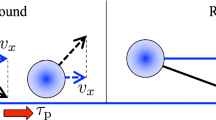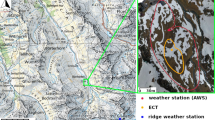Abstract
A series of experiments have been made in a wind tunnel to investigate the ventilation of snow by shear. We argue that the zero-plane displacement can be used as a convenient indicator of ventilation, and that this can be obtained from measurements of mean velocity profiles in conditions of zero pressure gradient. Measurements made over a natural snow surface show a zero-plane displacement depth of less than 5 mm, but practical considerations preclude extensive use of snow for these measurements. Instead, the influence of permeability is investigated using reticulated foams in place of snow. We demonstrate that the foam and snow have similar structure and flow-relevant properties. Although the surface of the foam is flat, the roughness lengths increase by two orders of magnitude as the permeability increases from 6 × 10−9 to 160 × 10−9 m2. The zero-plane displacement for the least permeable foams is effectively zero, but more than 15 mm for the most permeable foams. Our data compare well to the few studies available in the literature. By analogy to conditions over snow surfaces, we suggest that shear-driven ventilation of snow is therefore limited to the upper few millimetres of snow surfaces.
Similar content being viewed by others
References
Albert M, Perron F (2000) Ice layer and surface crust permeabilty in a seasonal snow pack. Hydrol Process 14: 3207–3214
Albert M, Schultz E (2002) Snow and firn properties and air-snow transport processes at Summit, Greenland. Atmos Environ 36: 2789–2797
Albert M, Schultz E, Perron F (2000) Snow and firn permeability at S. Ann Glaciol 31: 353–356
Albert M, Grannas A, Bottenhiem J, Shepson P, Perron F (2002) Processes and properties of snow-air transfer in the high A. Atmos Environ 36: 2779–2787
Andreas E, Jordan R, Makshtas A (2005) Parameterizing turbulent exchange over sea ice: the I. Boundary-Layer Meteorol 114: 439–460
Bhaganagar K, Kim J, Coleman G (2004) Effect of roughness on wall-bounded turbulence. Flow, Turbul Combust 72: 463–492
Box J, Bromwhich D, Bai LS (2004) Greenland ice sheet surface mass balance for 1991–2000: application of Polar MM5 mesoscale model and in-situ data. J Geophys Res 109(D16). Doi 10.1029/2003JD004451
Breugem W, Boersma B, Uittenbogaard R (2006) The influence of wall permeability on turbulent channel flow. J Fluid Mech 562(1): 35–72
Clauser F (1954) Turbulent boundary layers in adverse pressure gradients. J Aeronaut Sci 21: 91–105
Clifton A, Rüedi JD, Lehning M (2006) Snow saltation threshold measurements in a drifting-snow wind tunnel. J Glaciol 52(179): 585–596
Colbeck S (1989) Air movement in snow due to windpumping. J Glaciol 35(120): 209–213
Doorschot J, Lehning M, Vrouwe A (2004) Field measurements of snow drift and mass fluxes and comparison with model simulations. Boundary-Layer Meteorol 113: 347–368
Garratt J R (1994) The atmospheric boundary layer. Cambridge University Press, U.K., 316 pp
Jackson P (1981) On the displacement height in the logarithmic velocity profile. J Fluid Mech 111: 15–25
King JC, Turner J (1997) Antarctic meteorology and climatology. Cambridge University Press, U.K., 425 pp
Lehning M, Bartelt P, Brown B, Fierz C (2002) A physical SNOWPACK model for the Swiss avalanche warning part III: meteorological forcing, thin layer formation and evaluation. Cold Reg Sci Technol 35(3):169–184
Manes C (2006) Turbulent open channel flow over and within rough and permeable beds. PhD thesis, University of Aberdeen
McKeon B, Li J, Jiang W, Morrison J, Smiths A (2003) Pitot probe corrections in fully developed turbulent pipe flow. Meas Sci Technol 14: 1449–1458
Moffat R (1982) Contributions to the theory of single-sample uncertainty analysis. J Fluids Eng 104: 250–260
Nikora V, Koll K, McLean S, Dittrich A, Aberle J (2002) Zero-plane displacement for rough-bed open-channel flows. In: Bousmar D (ed) River Flow 2002 : proceedings of the International Conference on Fluvial Hydraulics, Louvain-la-Neuve, Belgium, 4–6 September 2002, International Conference on Fluvial Hydraulics
Raupach M (1991) Saltation layers, vegetation canopies and roughness lengths. Acta Mechanica (Suppl) (1):83–96
Raupach MR, Antonia R, Rajagopalan S (1991) Rough-wall turbulent boundary layers. Appl Mech Rev 44(1): 1–24
Schlichting H, Gersten K (2003) Boundary layer theory, 8th edn. Springer Verlag, 799 pp
Schneebeli M, Sokratov S (2004) Tomography of temperature gradient metamorphism of snow and associated changes in heat conductivity. Hydrol Process 18: 3655–3665
Sokratov S, Sato A (2000) Wind propagation to snow observed in laboratory. Ann Glaciol (31):427–433
Sokratov S, Sato A (2001) The effect of wind on the snow cover. Ann. Glaciol (32)
Sommerfeld R, Rocchio J (1993) Permeability measurements on new and equitemperature snow. Water Resour Res 29(8): 2485–2490
Sturm M, Johnson B (1991) Natural convection in the subarctic snow cover. J Geophy Res 96(B7): 11,657–11,671
Thom A (1971) Momentum absorption by vegetation. Quart J Roy Meteorol Soc 97: 414–428
Waddington E, Cunningham J (1996) The effect of snow ventilation on chemical concentrations. In: Wolff EW, Bales RG (eds) Chemical exchange between the atmosphere and polar snow, NATO ASI series, vol. 143, pp 403–451
Zagni A, Smith K (1976) Channel flow over permeable beds of graded spheres. J Hydraulics Division ASCE 102: 207–22
Zippe H, Graf W (1983) Turbulent boundary-layer flow over permeable and non-permeable rough surfaces. J Hydraulic Res 21(1): 51–65
Author information
Authors and Affiliations
Corresponding author
Rights and permissions
About this article
Cite this article
Clifton, A., Manes, C., Rüedi, JD. et al. On Shear-Driven Ventilation of Snow. Boundary-Layer Meteorol 126, 249–261 (2008). https://doi.org/10.1007/s10546-007-9235-0
Received:
Accepted:
Published:
Issue Date:
DOI: https://doi.org/10.1007/s10546-007-9235-0




